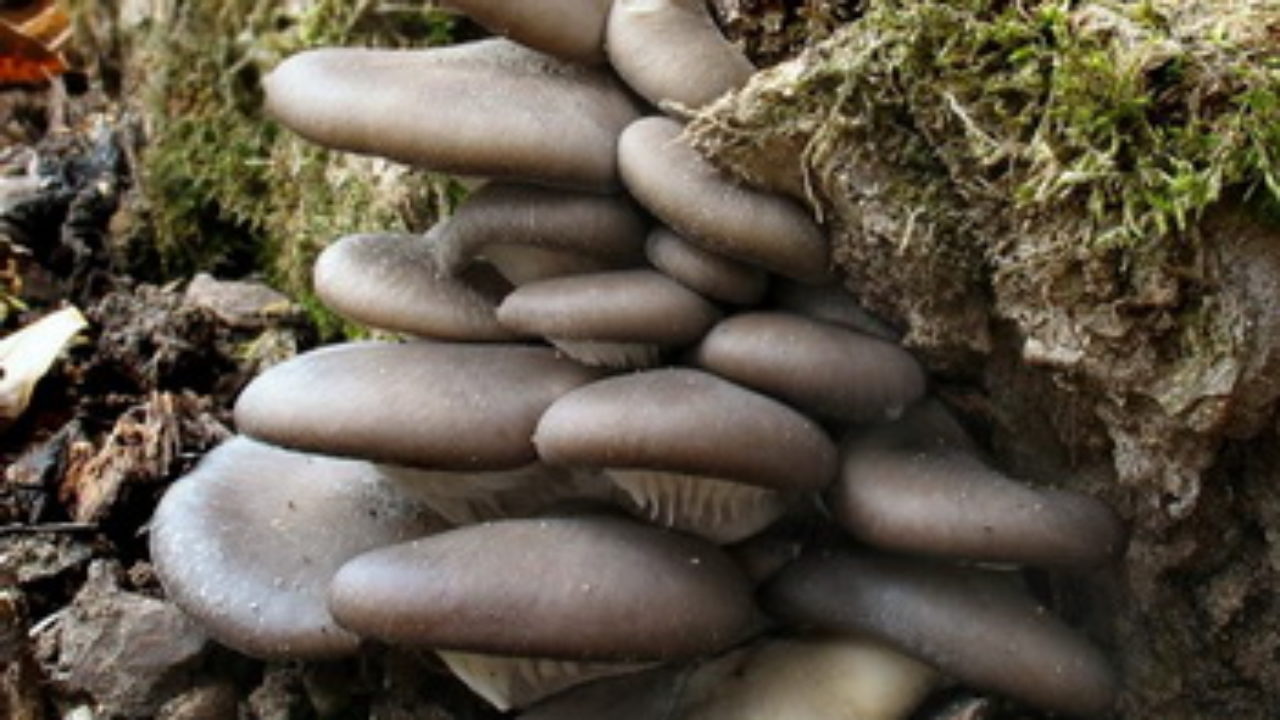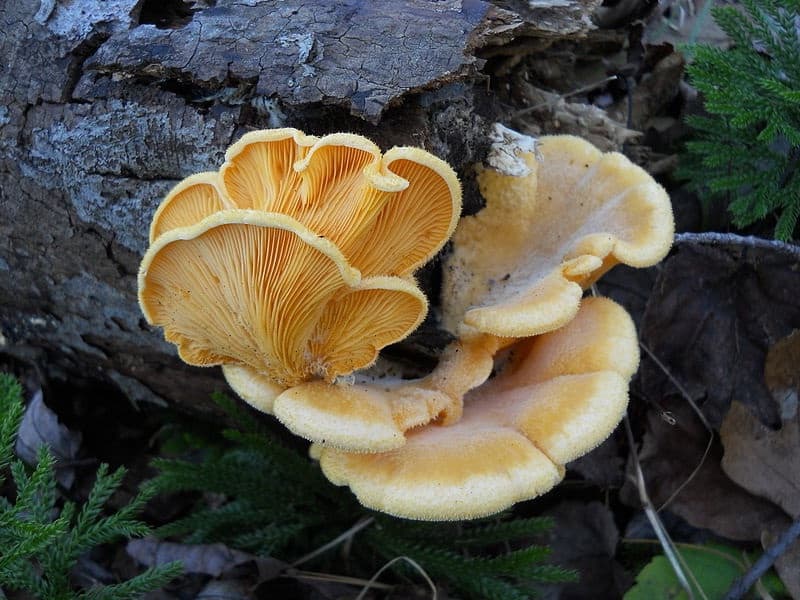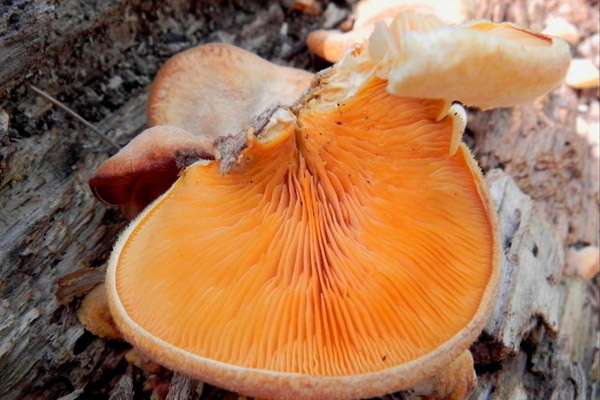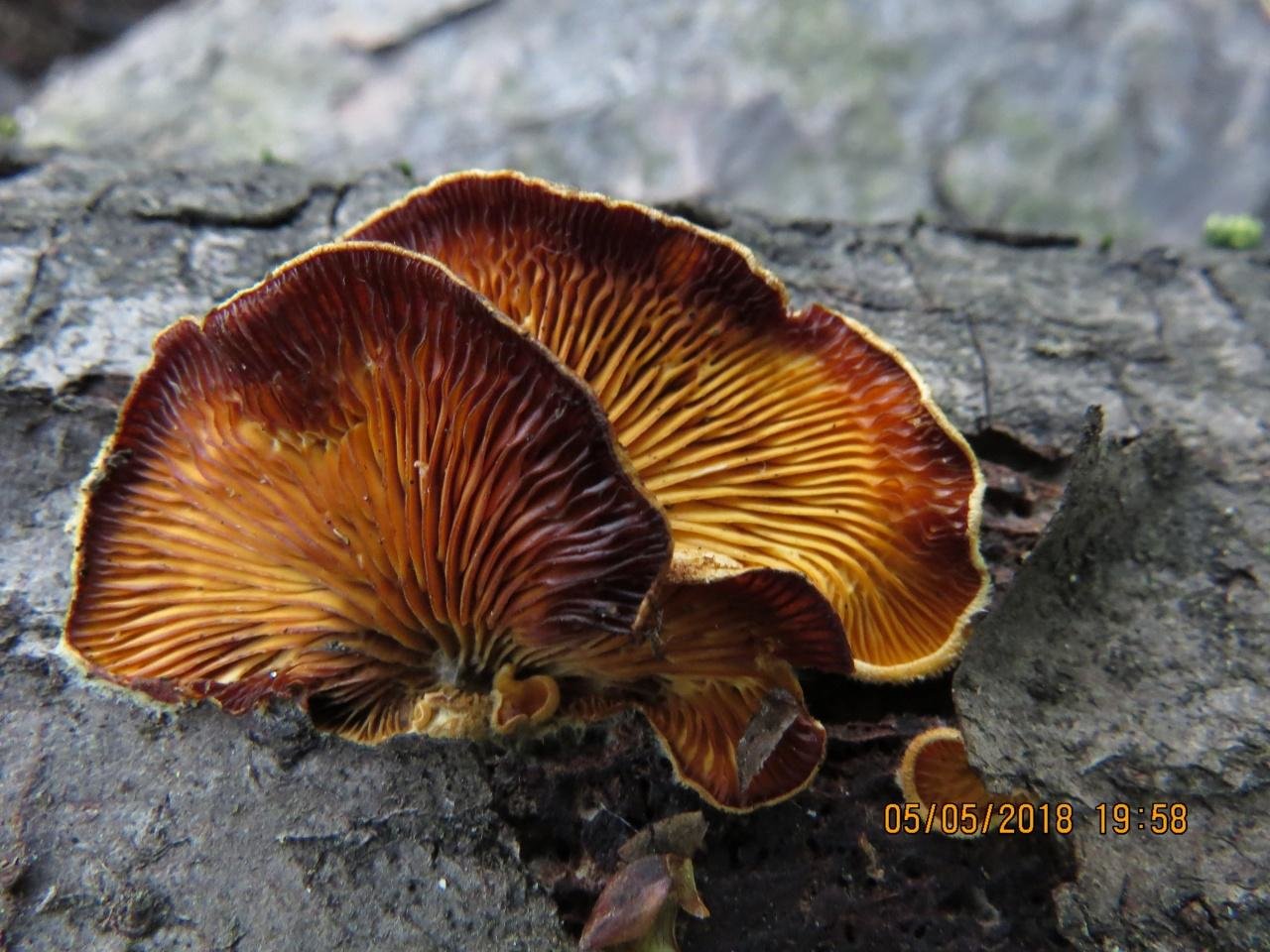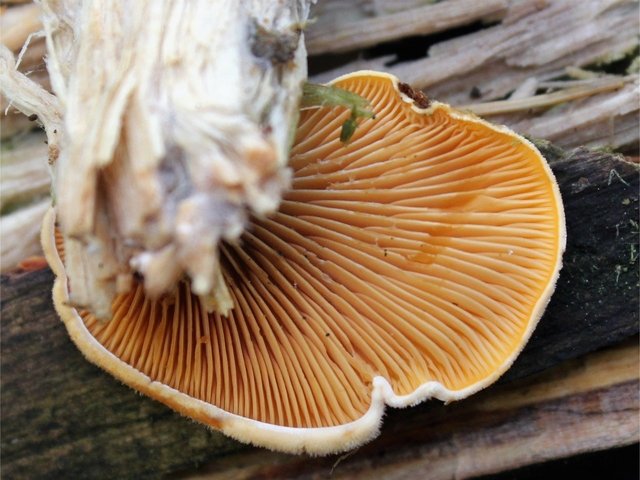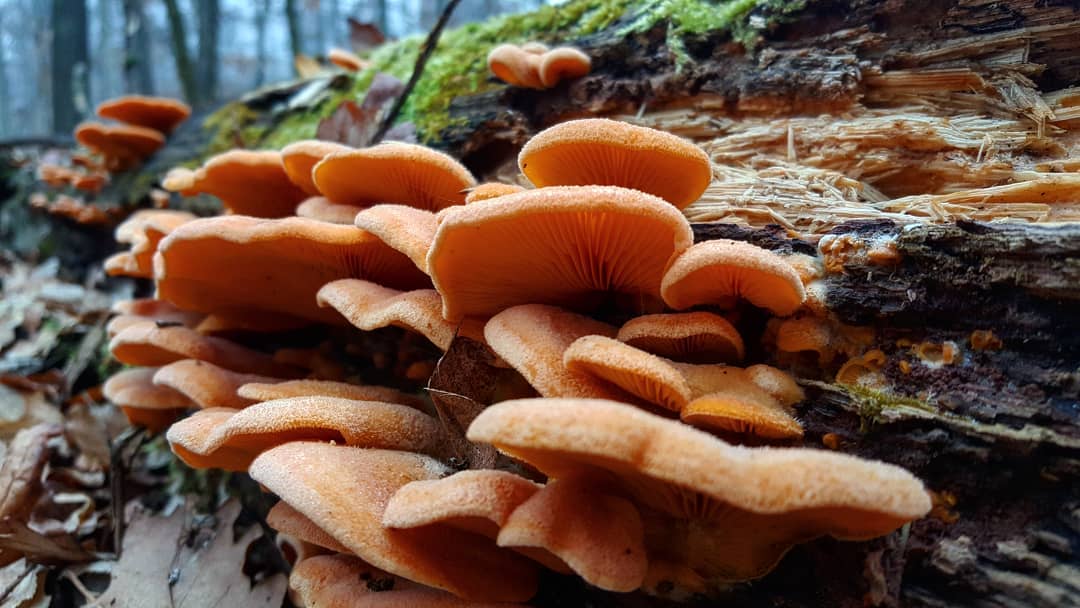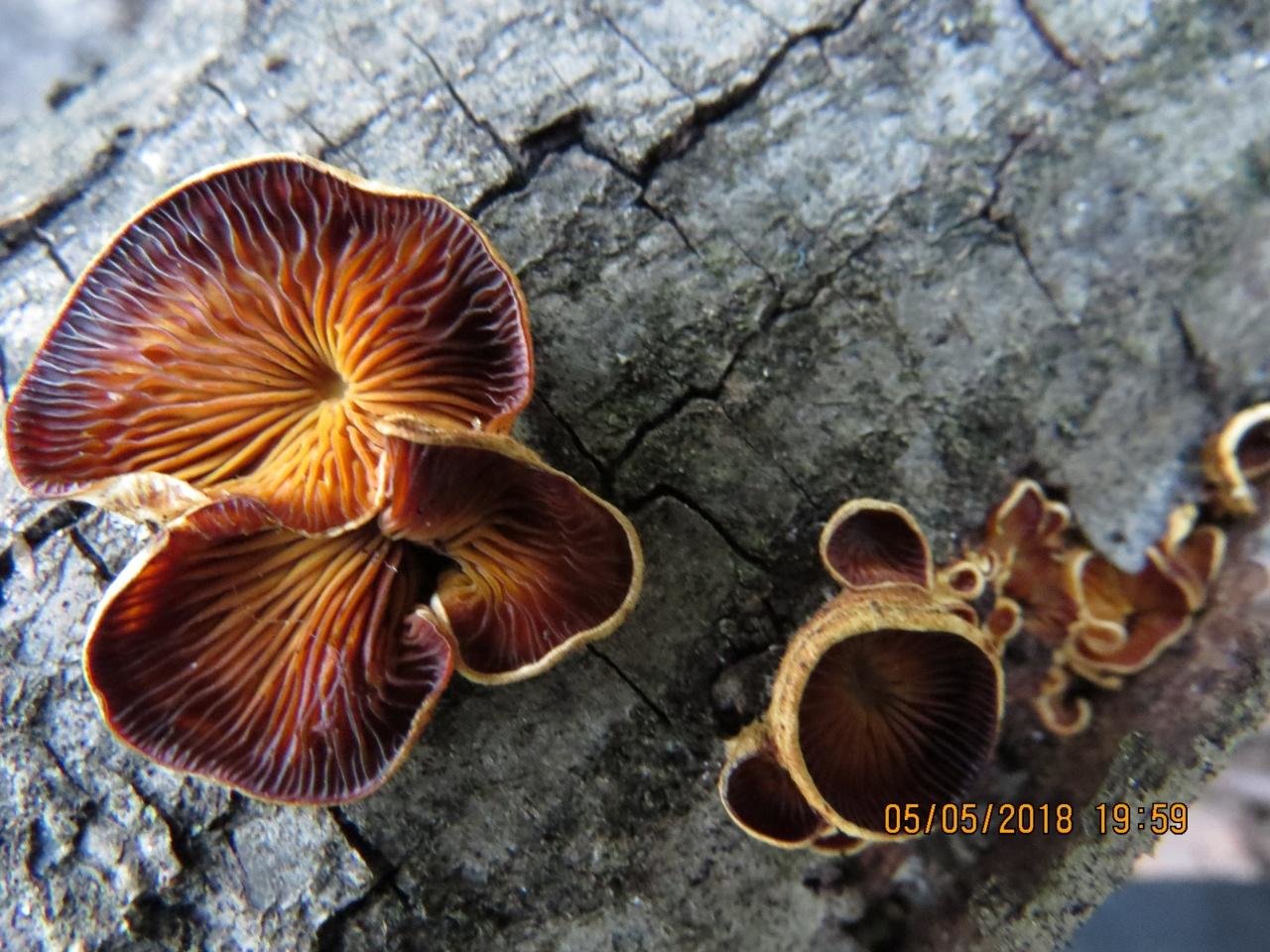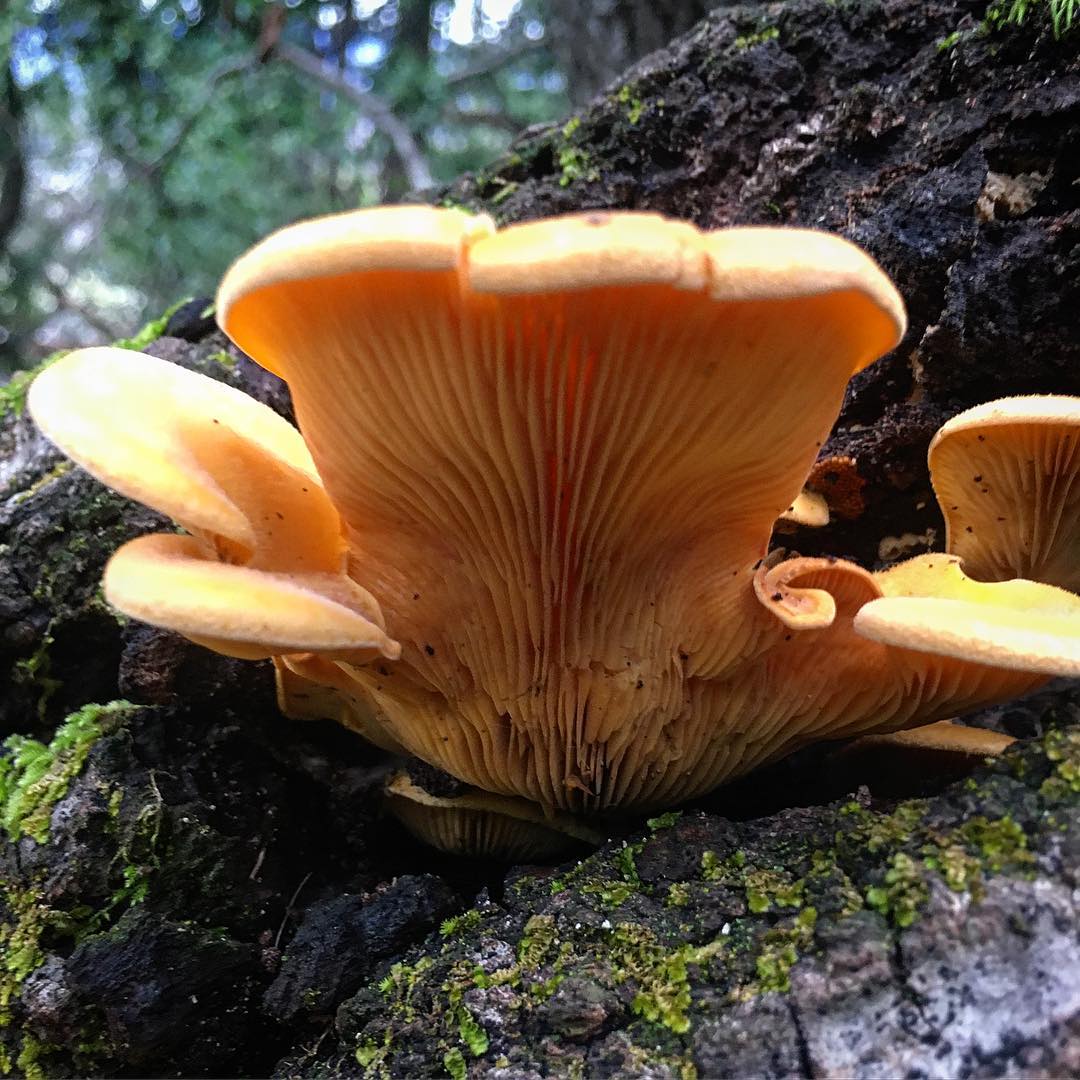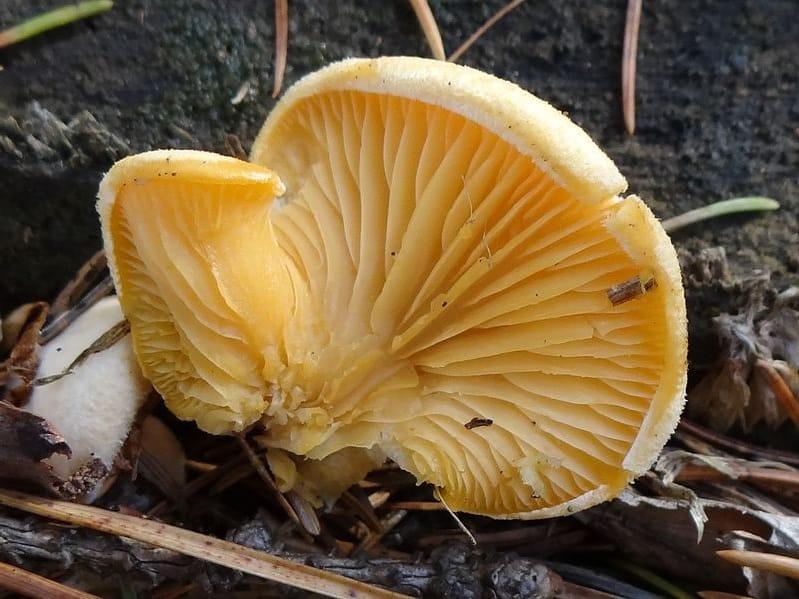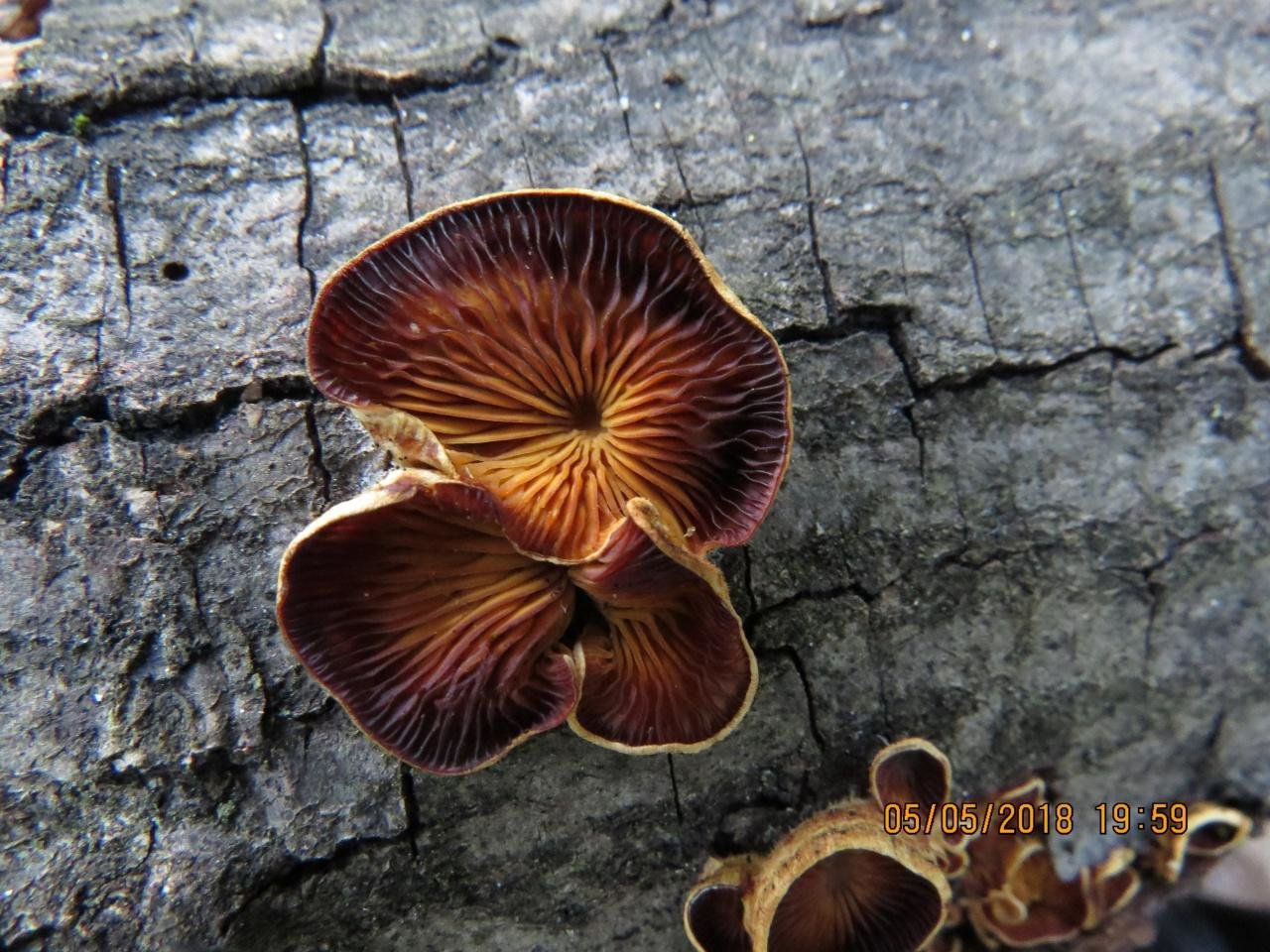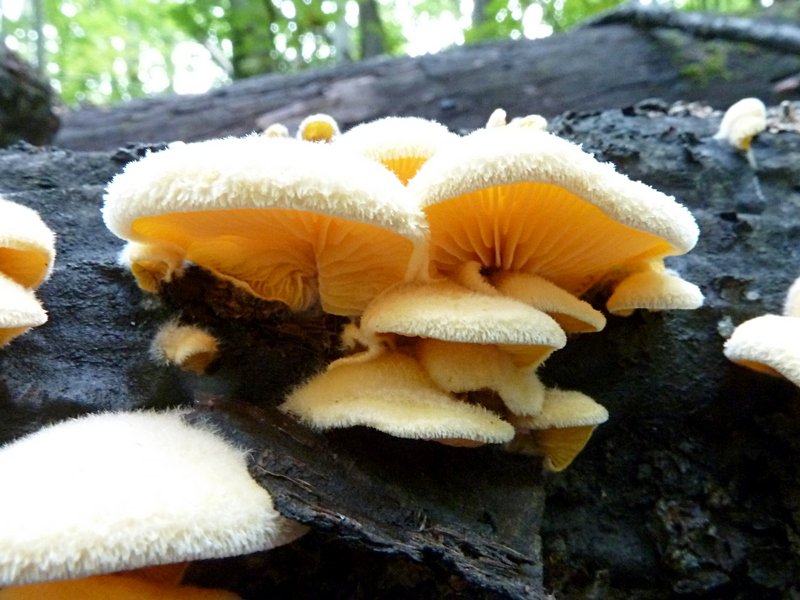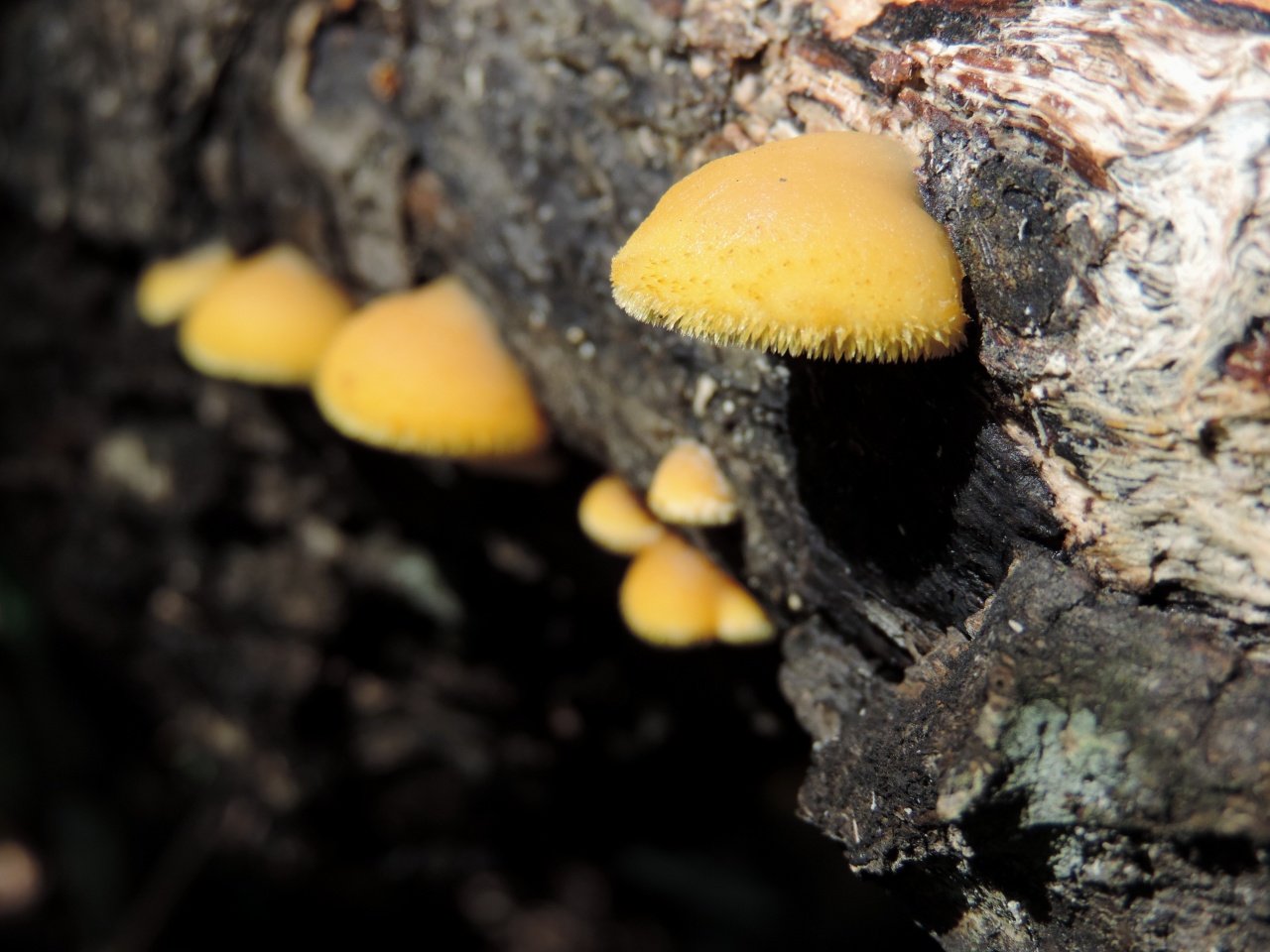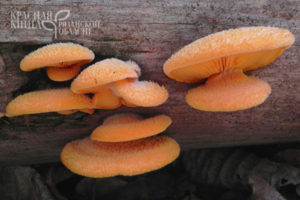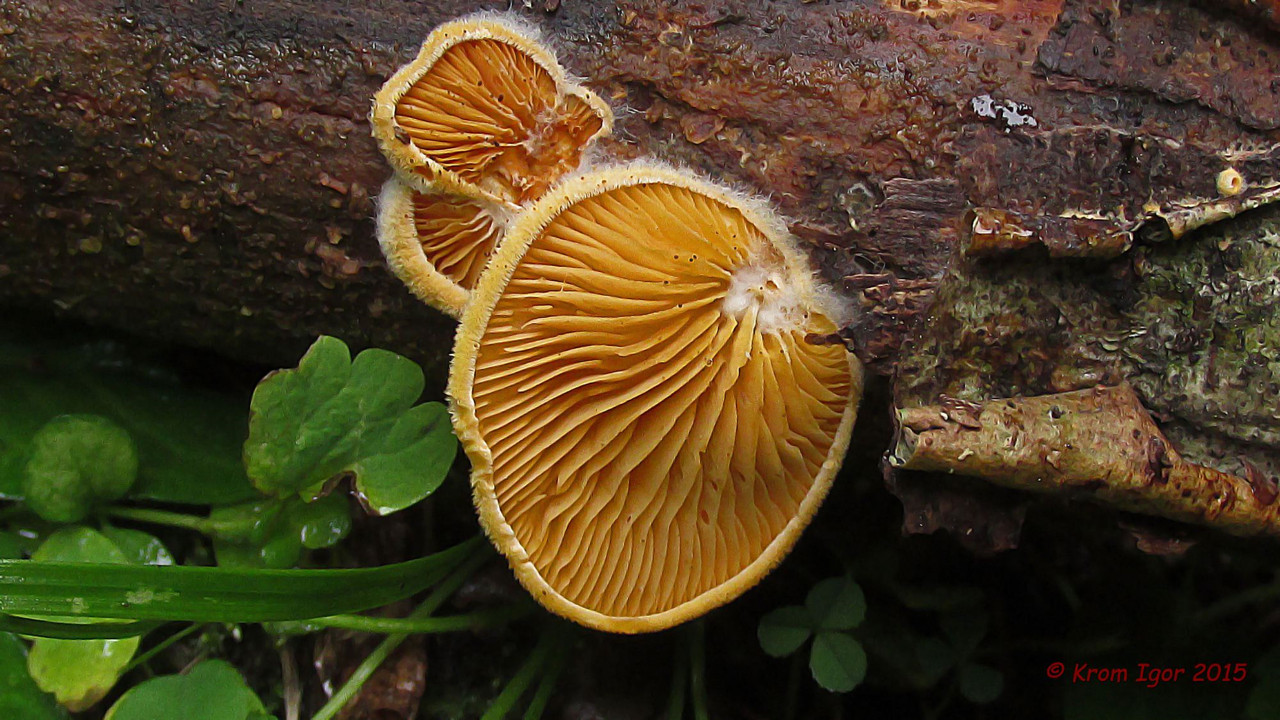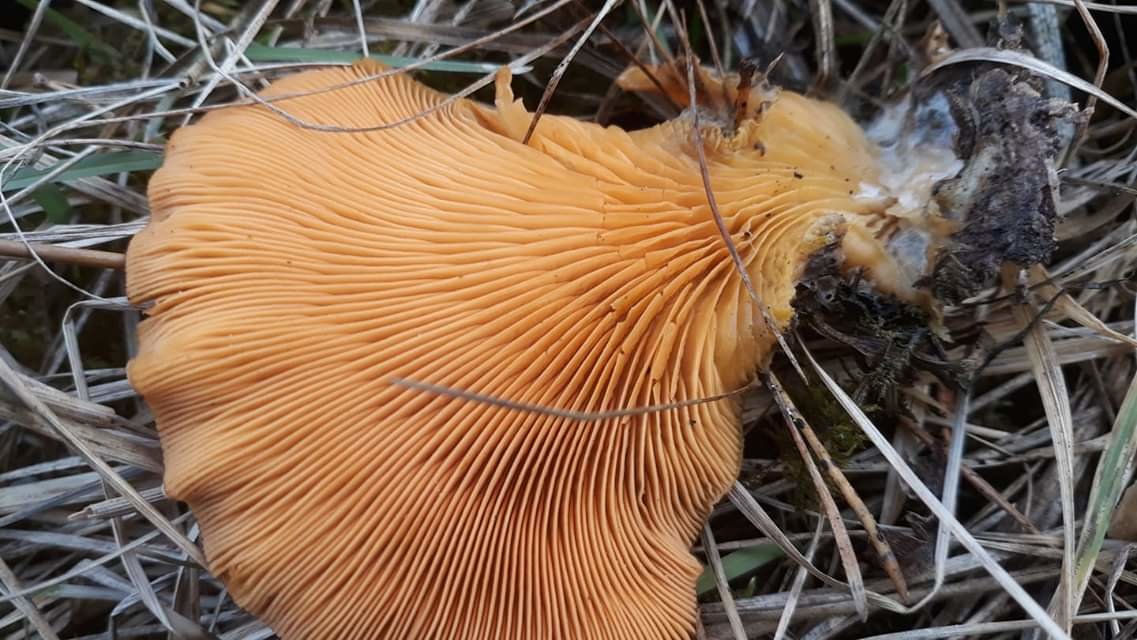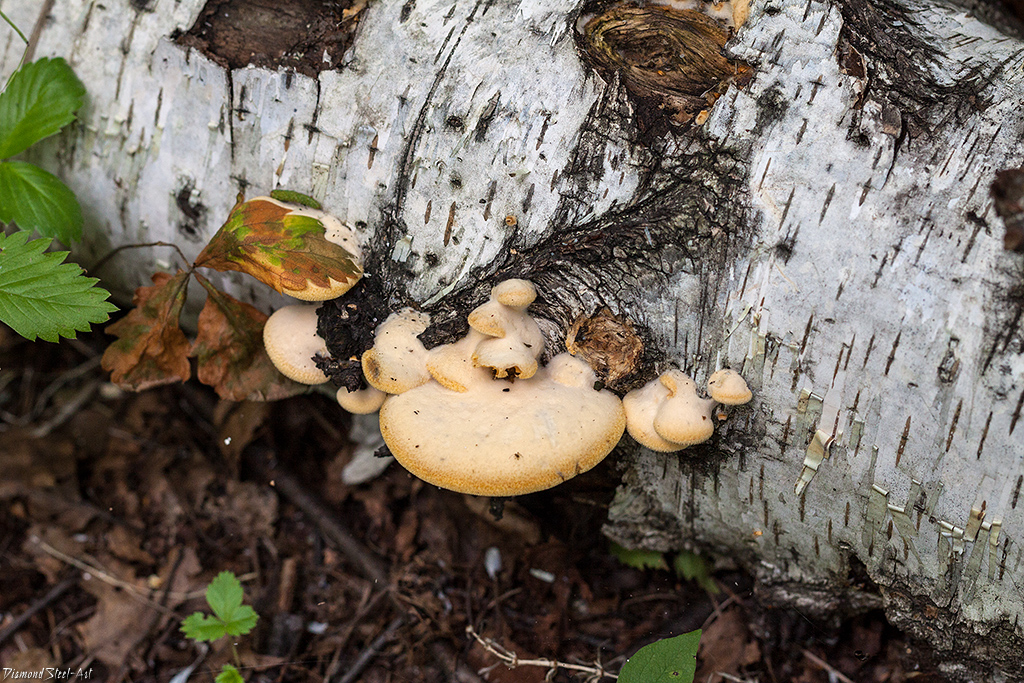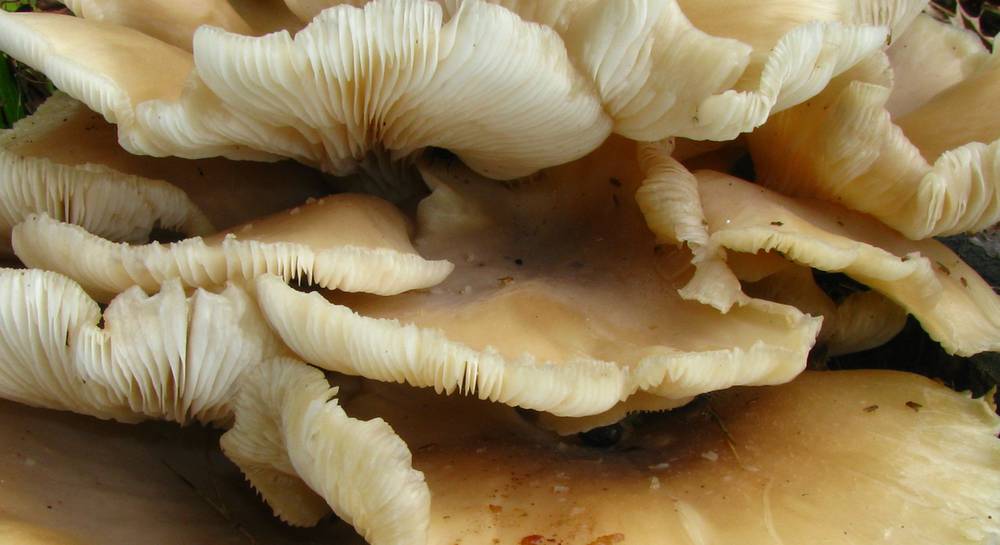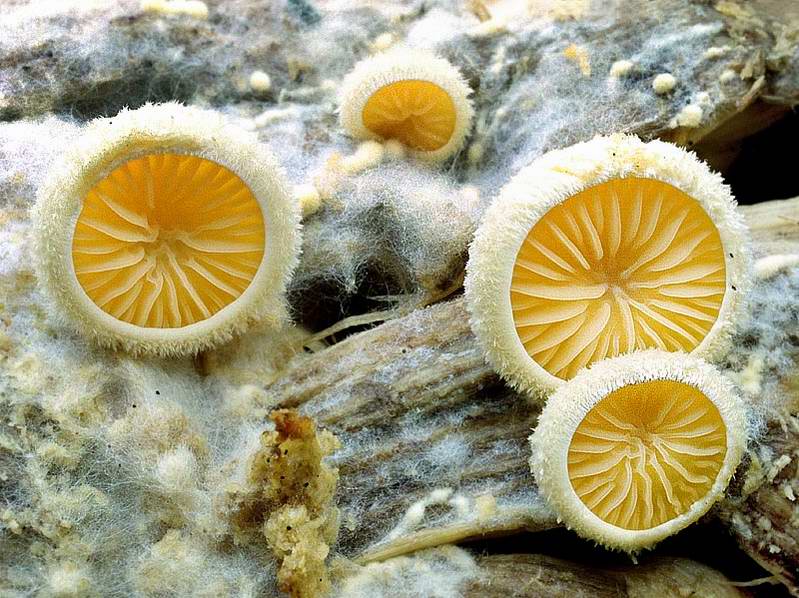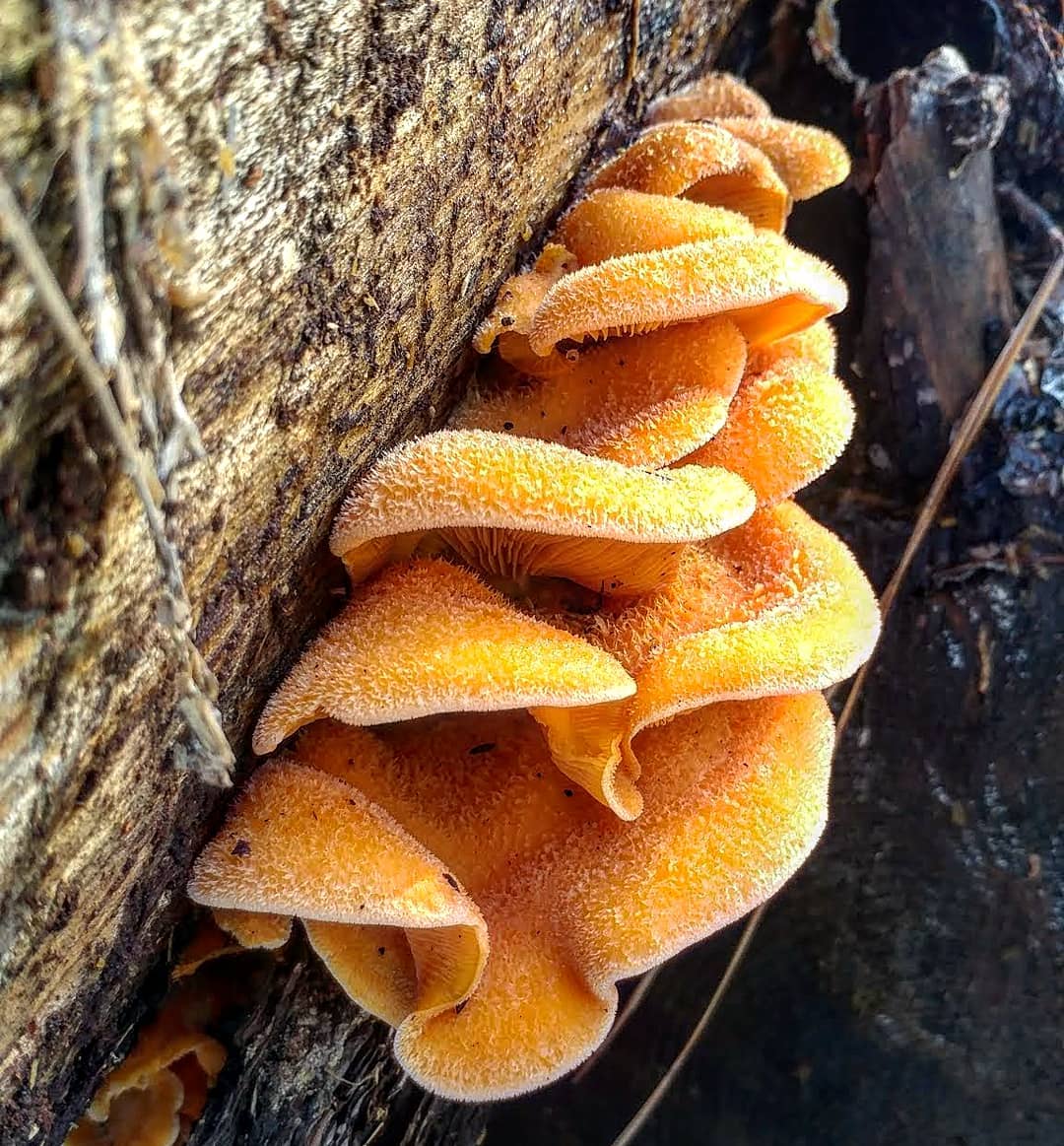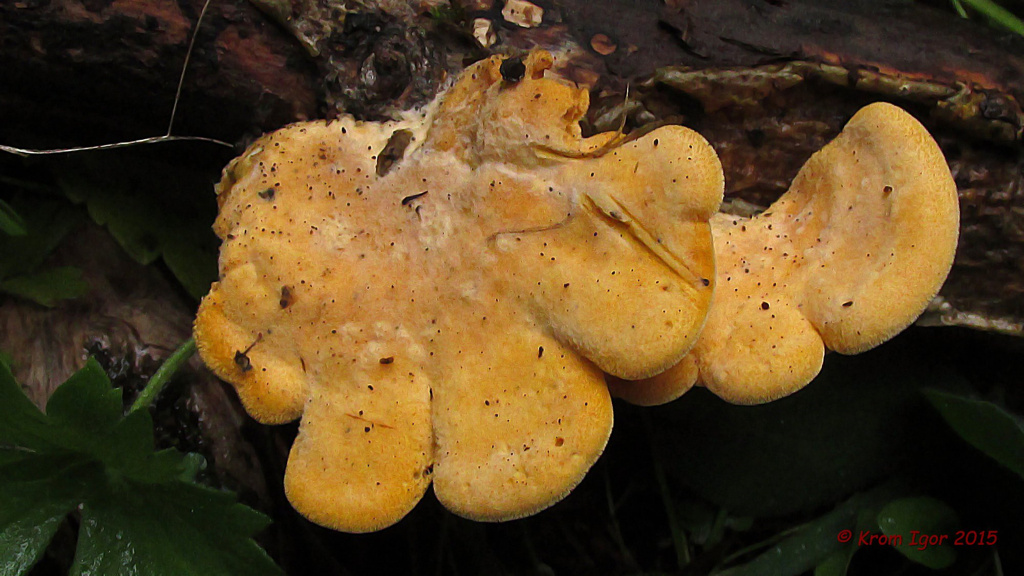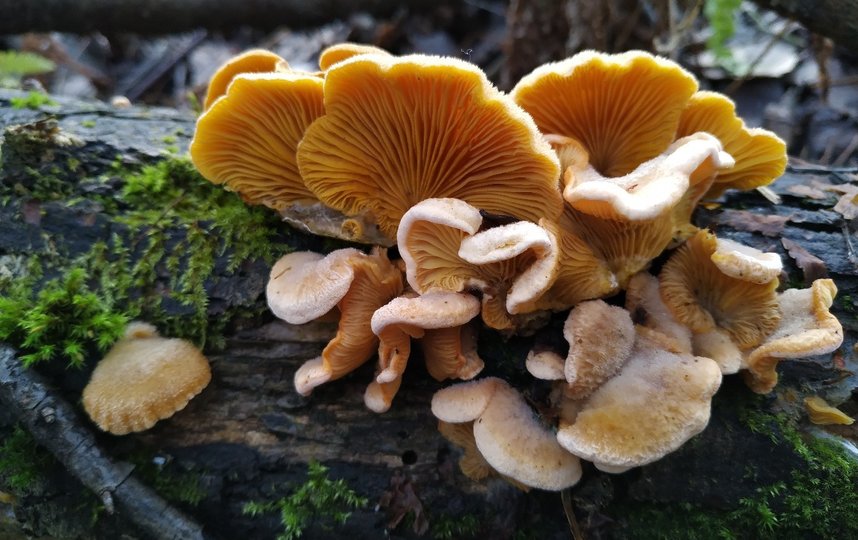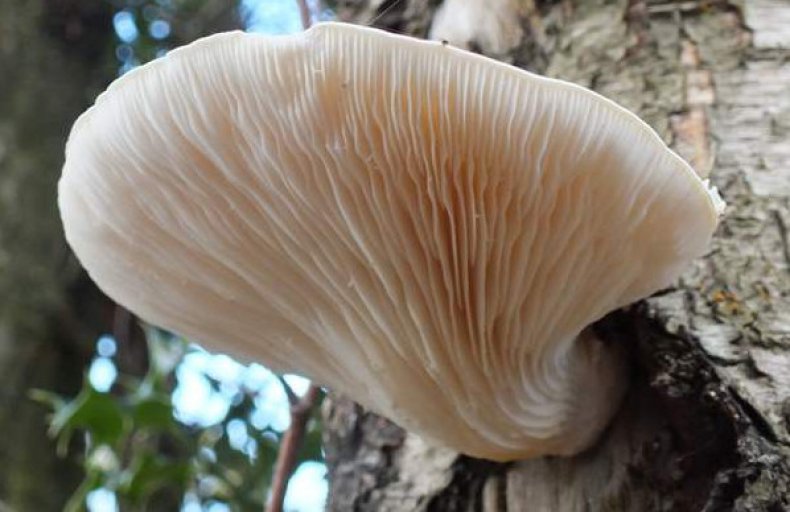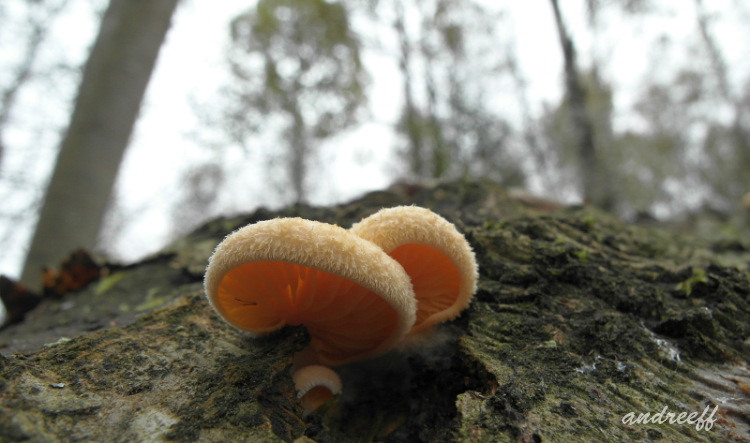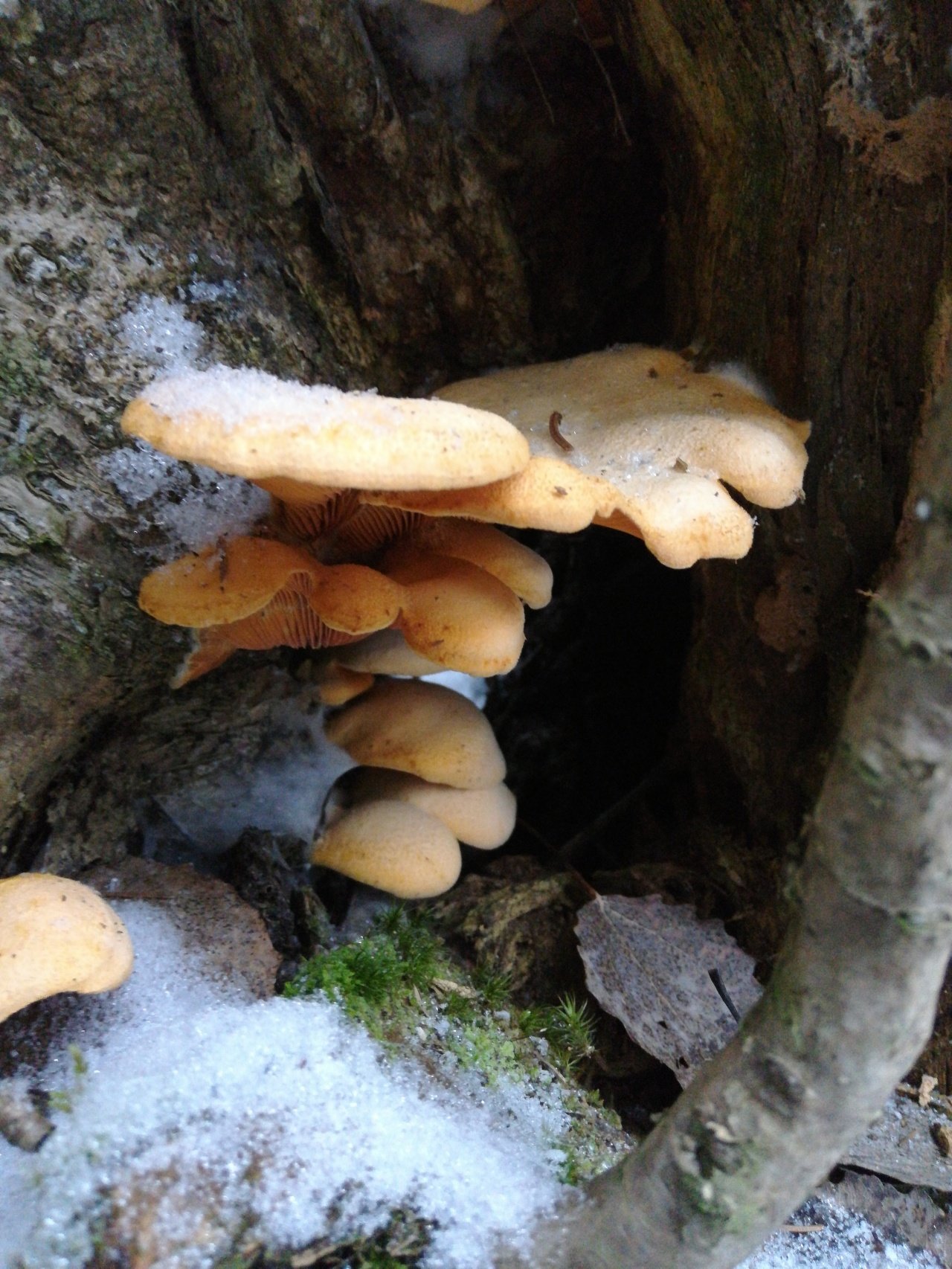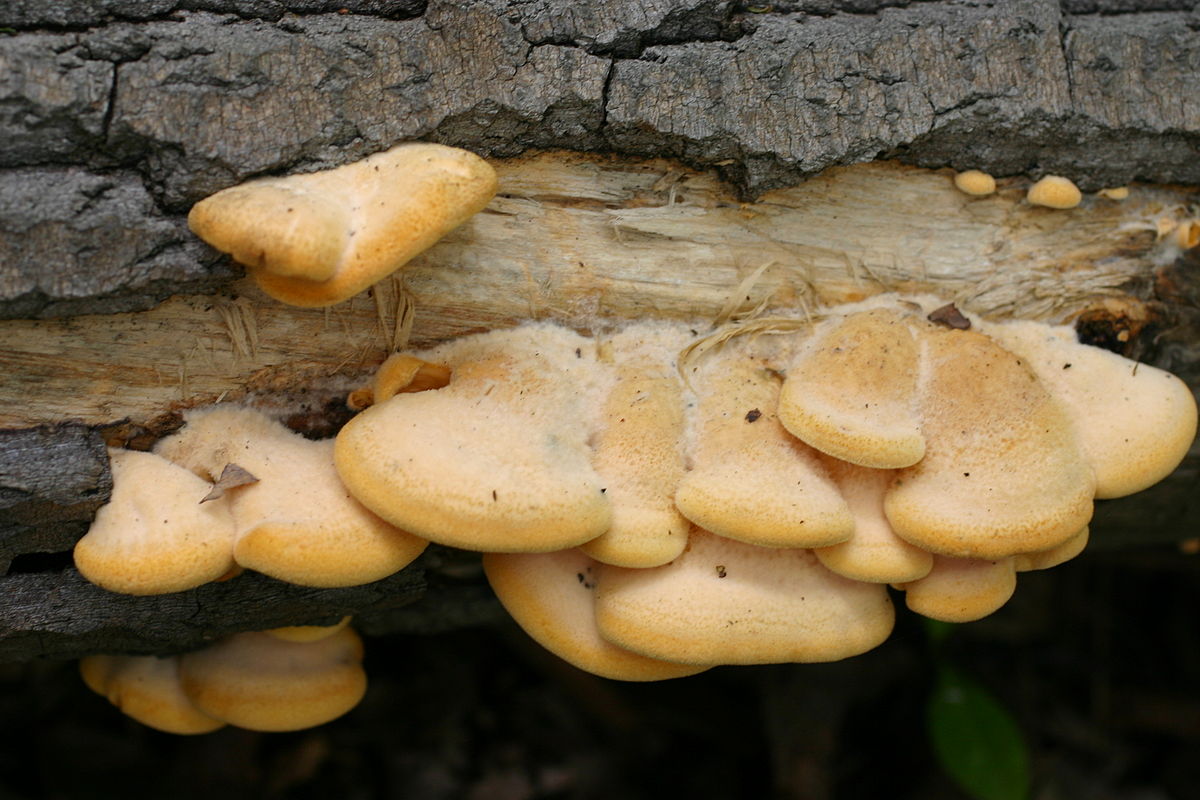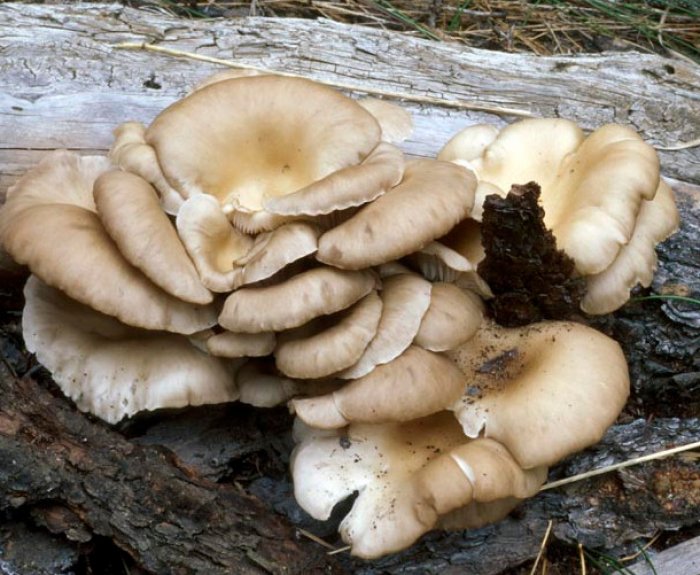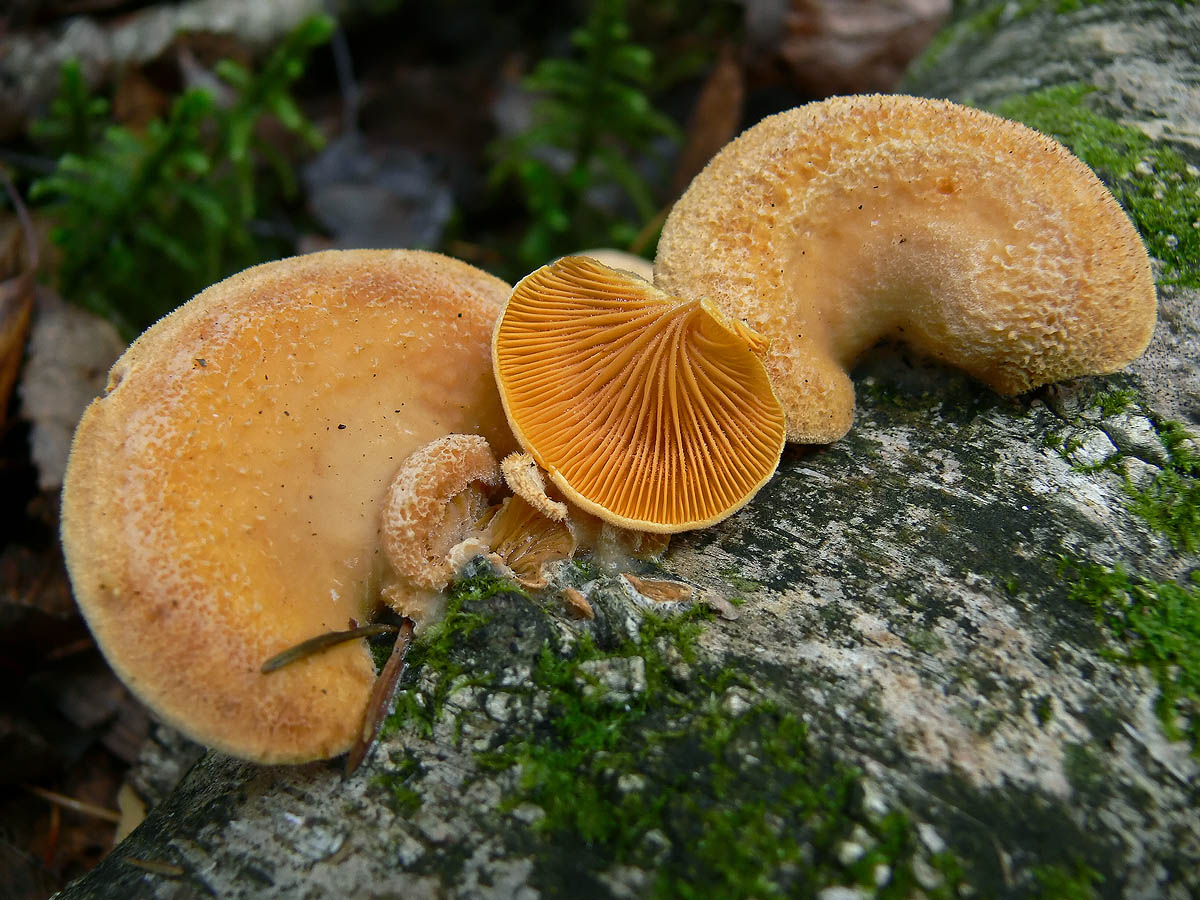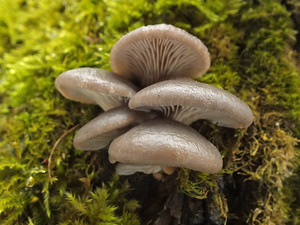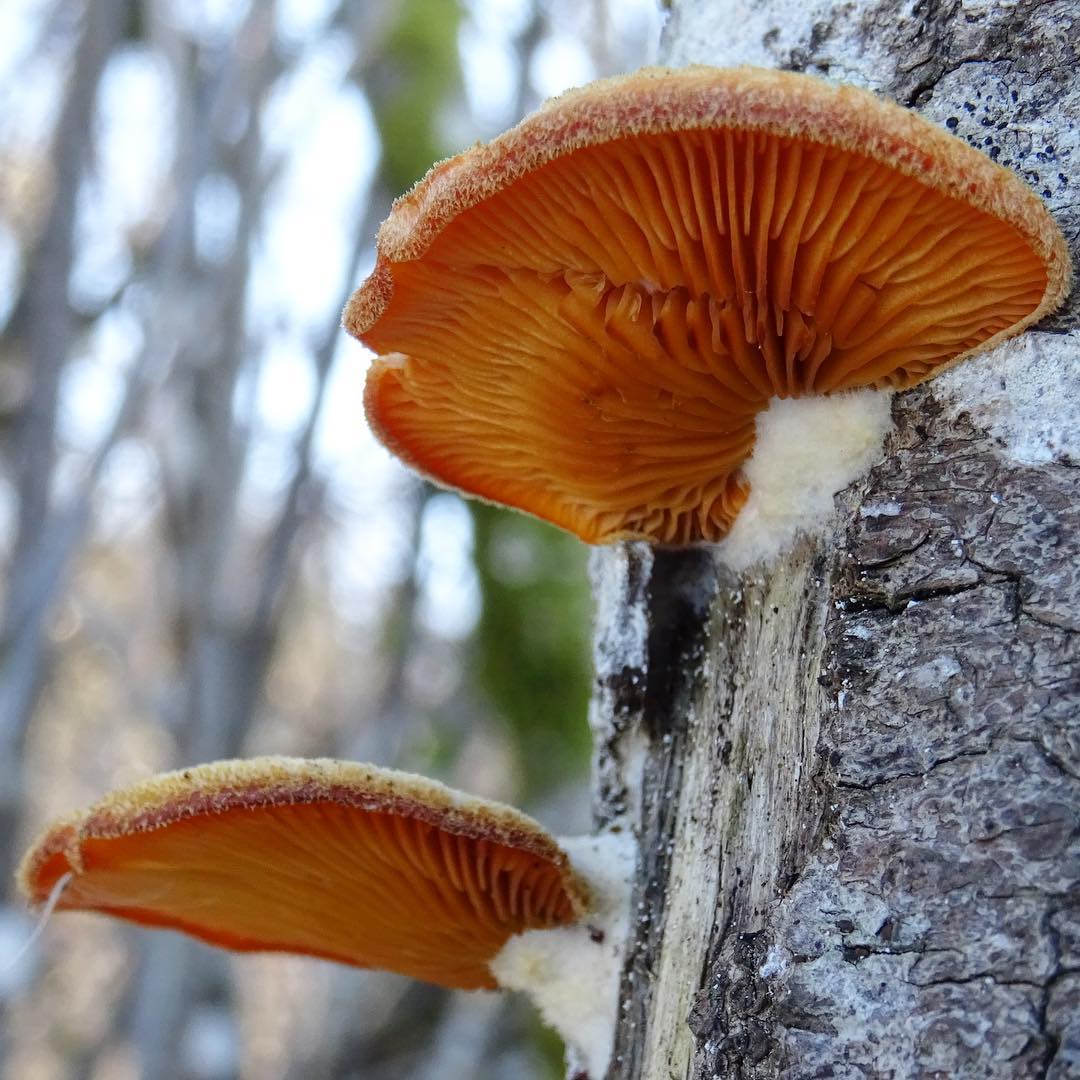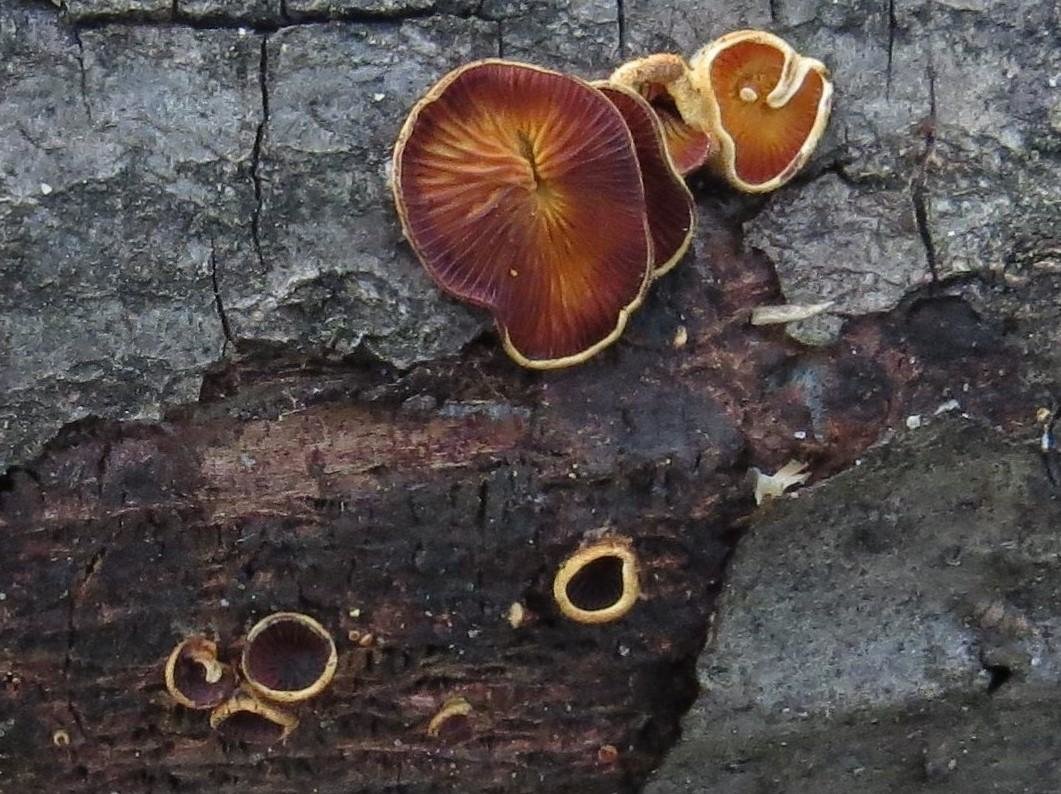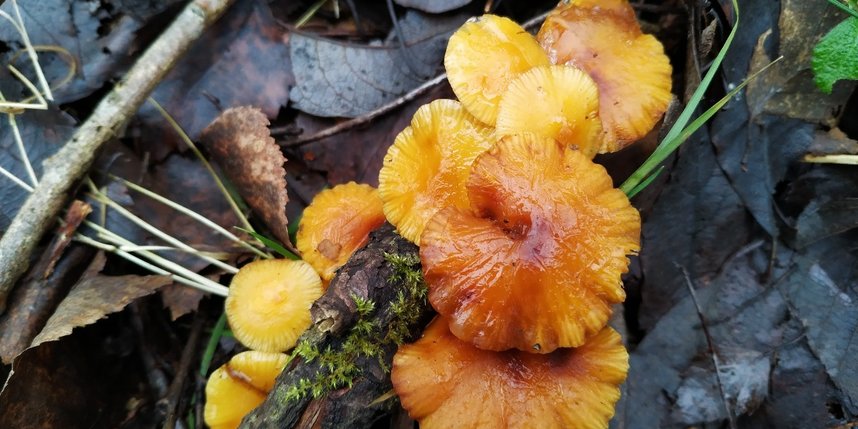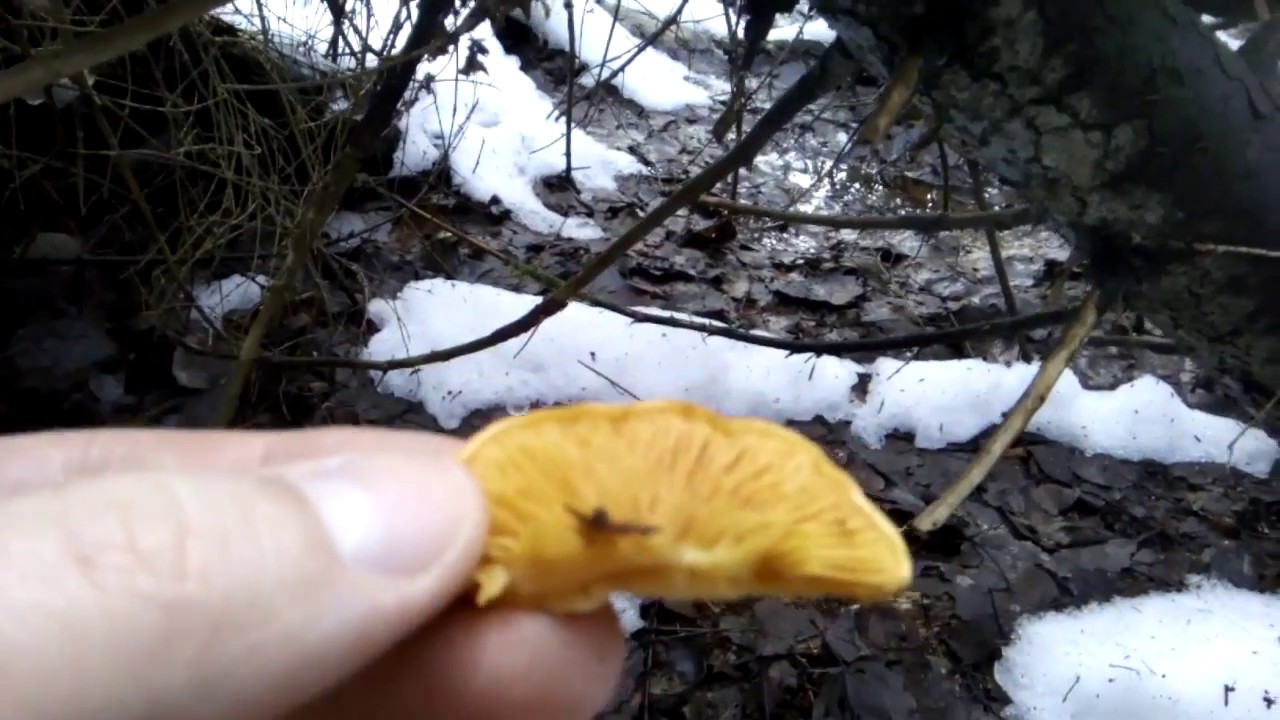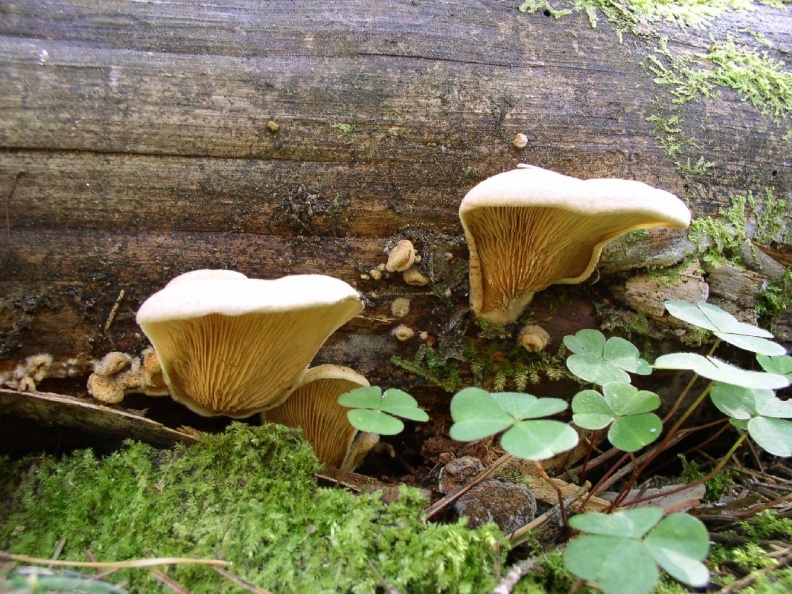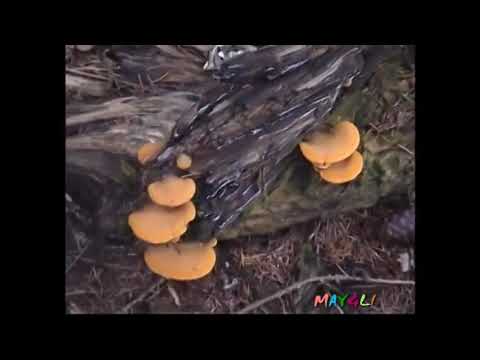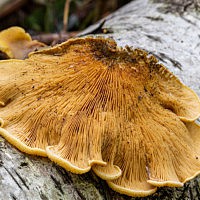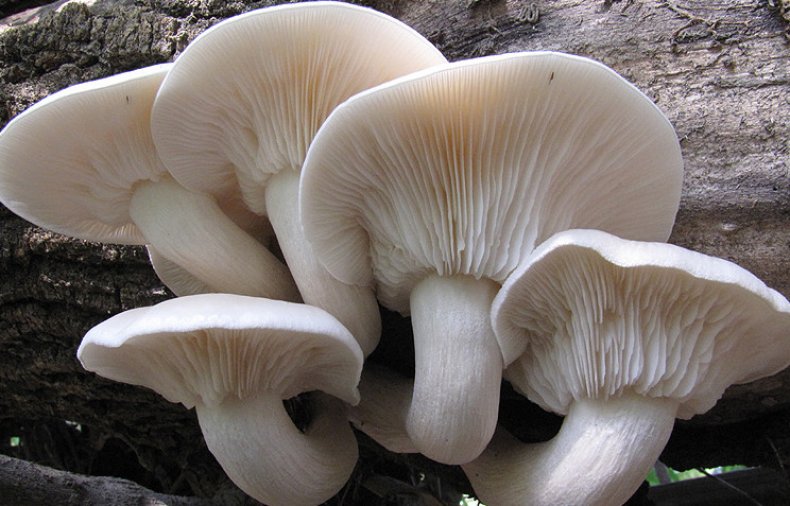Orange oyster mushroom: where it grows, what it looks like, is it possible to eat, false doubles, collection

Orange oyster mushroom belongs to the family Ryadovkovye, genus Phillotopsis. Other names - Phyllotopsis nest / nest. It is a sessile, stemless fungus that grows in trees. The Latin name for orange oyster mushroom is phyllotopsis nidulans.
Where does orange oyster mushroom grow?
The fungus is quite rare. Distributed in the temperate climatic zone of North America and Europe, including Russia. It settles on stumps, deadwood, branches of trees - both deciduous and coniferous. Grows in small groups, sometimes singly. Fruiting in autumn (September-November), in warmer climates and in winter.
What does orange oyster mushroom look like?
It differs from other oyster mushrooms in noticeable beautiful fruiting bodies with a bright color.
The cap is 2 to 8 cm in diameter. It is flat-convex, fan-shaped, pubescent, and grows to the trunk sideways or apex. In young specimens, the edge is tucked up, in old specimens it is lowered, sometimes wavy. The color is orange or orange-yellow, darker in the middle, with concentric, rather blurred banding. The surface is smooth. Mushrooms that survived the winter look faded.
The pulp is light orange in color, rather thin, dense, rather tough.
The spore-bearing layer consists of frequent, wide orange or dark orange plates that diverge from the base. The powder is pale pink or brownish pinkish. Spores are smooth, oblong, elliptical in shape.
The nest-like phyllotopsis does not have a leg.
Phyllotopsis nesting in the spring forest
Is it possible to eat phyllotopsis nesting
It belongs to conditionally edible, but is practically not eaten due to its hardness, bad smell and unpleasant bitter taste. Some mushroom pickers believe that young specimens are quite suitable for use in cooking. It belongs to the fourth flavor category.
Flavoring characteristics depend on the substrate and age. The smell is described as strong, fruity or melon to rot. The taste of the young is mild, the mature is putrid.
False doubles
Despite the fact that orange oyster mushrooms are difficult to confuse with other mushrooms, there are several similar species.
Tapinella is panus-shaped. The main difference is that the fruit body is brownish or brownish. The pulp is rather thick, yellowish-creamy or light brown, darkens on the cut, smells like resin or needles.
The size of the cap is from 2 to 12 cm, the surface is velvety, light ocher, yellow-brown, the edge is wavy, serrated, uneven. Its shape is lingual, lozenge-shaped, dome-shaped, fan-shaped. The plates are frequent, narrow, creamy, brownish-orange or yellow-orange.
Panus-shaped tapinella is easily distinguished by the color of the fruit body and the thickness of the flesh.
Phillotopsis is weakly nesting. In these mushrooms, the color of the fruit bodies is brighter, the flesh is thinner, the plates are sparse and narrow.
Grows in smaller groups, belongs to inedible species
Crepidote saffron-lamellar. It differs from oyster mushroom orange brownish scales on the surface of the fruiting body. An inedible mushroom with a sessile cap without a leg is attached to the place of growth by the tip or lateral edge. The pulp is odorless, thin, white.
A hat with a wrapped straight edge, its size is from 1 to 5 cm, the shape is semicircular, kidney-shaped. Its light skin is covered with small scales of light brown or yellowish orange color. The plates are frequent, narrow, radially diverging, pale orange, yellow, apricot, with a lighter edge.
Crepidote saffron-lamellar give out noticeable brownish scales
Phyllotopsis nesting a little resembles late oyster mushroom, or alder. The difference is in the presence of the short leg and the color of the cap.It can be greenish-brown, olive-yellow, olive, gray-lilac, pearl. The mushroom is conditionally edible, requires mandatory heat treatment.
Late oyster mushroom is distinguished by a layer of pulp under the skin of the cap, resembling gelatin
Collection rules and use
Experienced mushroom pickers recommend picking only young specimens that are not too tough and have not acquired an unpleasant smell and taste. Harvesting begins in early autumn and can continue even during the cold season. It is very easy to look for orange oyster mushrooms - they can be seen from afar, especially in winter.
Important! Fillotopsis nesting must be boiled for 20 minutes. Then drain the water, you can proceed to further cooking: frying, stewing
Orange oyster mushroom is rarely eaten. One of the most beautiful mushrooms can be used in landscaping, yard or garden decoration. To do this, it is necessary to bring mycelium onto tree trunks and stumps. They look especially impressive in winter.
Orange oyster mushroom
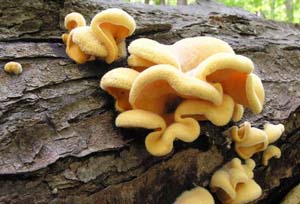 Other names: Pleurotus nidulans; Crepidotus nidulans; Phyllotopsis is nest-like, nesting or nesting. Orange oyster mushroom (Pleurotus nidulans), or nesting, has an ocher-yellow velvety-pubescent cap turned down. The cap (up to 8 cm) of some oyster mushrooms appears whitish. The fungus sometimes grows so tightly to the wood that the cap breaks during collection. There is no leg at all, or it is very short. The pulp of orange oyster mushroom is thin, juicy, rusty yellow. The smell of young pulp is compared to that of a melon. The old mushroom smells like ... rotten cabbage. The plates of the cap are frequent, descending, orange. Spores are colorless. This rarer species of oyster mushroom bears fruit on dead coniferous and deciduous wood in June - September. It can be seen on rotten tree stumps and dead wood. Sometimes orange oyster mushroom grows on sick or dying trees (birch, aspen). In old reference books about the use of this mushroom, they evasively wrote "conditionally edible." Some mushroom pickers consider only young mushrooms edible. The hunt to take old mushrooms is discouraged by their dubious smell. Many modern identifiers mark this mushroom as inedible (but do not indicate that it is poisonous). The mycelium of this mushroom is on sale. Orange oyster mushroom is advertised as a mushroom - a garden decoration that is not intended to be eaten. The exception is very young mushrooms with a melon smell.
Other names: Pleurotus nidulans; Crepidotus nidulans; Phyllotopsis is nest-like, nesting or nesting. Orange oyster mushroom (Pleurotus nidulans), or nesting, has an ocher-yellow velvety-pubescent cap turned down. The cap (up to 8 cm) of some oyster mushrooms appears whitish. The fungus sometimes grows so tightly to the wood that the cap breaks during collection. There is no leg at all, or it is very short. The pulp of orange oyster mushroom is thin, juicy, rusty yellow. The smell of young pulp is compared to that of a melon. The old mushroom smells like ... rotten cabbage. The plates of the cap are frequent, descending, orange. Spores are colorless. This rarer species of oyster mushroom bears fruit on dead coniferous and deciduous wood in June - September. It can be seen on rotten tree stumps and dead wood. Sometimes orange oyster mushroom grows on sick or dying trees (birch, aspen). In old reference books about the use of this mushroom, they evasively wrote "conditionally edible." Some mushroom pickers consider only young mushrooms edible. The hunt to take old mushrooms is discouraged by their dubious smell. Many modern identifiers mark this mushroom as inedible (but do not indicate that it is poisonous). The mycelium of this mushroom is on sale. Orange oyster mushroom is advertised as a mushroom - a garden decoration that is not intended to be eaten. The exception is very young mushrooms with a melon smell.
Sometimes oyster mushrooms cover the trunk in several tiers up to 5 meters in height. In isolated cases, it grows with such force that it breaks through the old tinder fungus.
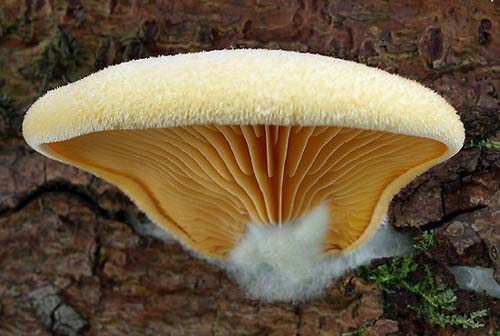
In adolescence, the fruiting body is reniform, shaggy, then nested, cylindrical with an inner depression, cupped, pubescent, hairy outside and with yellow plates inside, in maturity it unfolds into an oyster-like or cantilever, adherent sideways, velvety or relatively smooth (after rains) cap, with curled or lowered wavy-lobed edge. Sometimes the mushroom grows with its tip to the wood. The cap is light yellow, then dark yellow or olive yellow, with age it can fade to fawn. At the base, it is orange-yellow, with a yellowish edge, with white or yellowish tomentose pubescence, which is why it often seems whitish. The plates are wide, frequent, of different lengths, radiating from the base, descending along the peduncle, buffy, dark yellow or orange. Oyster mushroom often lacks a peduncle or is very short, located eccentrically. The pulp is watery, whitish, yellowish or rusty-yellow, with a bitter taste, without a special smell, with a melon smell or the stench of rotten carrots. According to G. Serzhanina and I. Zmitrovich, the mushroom starts to smell in old age. We also met mature specimens with an unbearable odor, a spore powder of ocher or pinkish color.
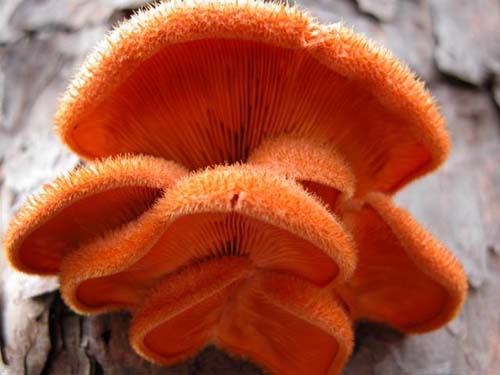
Twins: It resembles the late oyster mushroom (Panellus serotinus) growing in late autumn and warm winter.It is distinguished by an olive, olive-yellow or olive-brown cap, white spore powder and the smell of fresh vegetables. Slightly reminiscent of Crepidotus calolepis with smaller or equal-sized caps (white or creamy with many brown or ocher scales that can be washed away by rain). It has narrow, light ocher brown plates, odorless and sweetish taste.
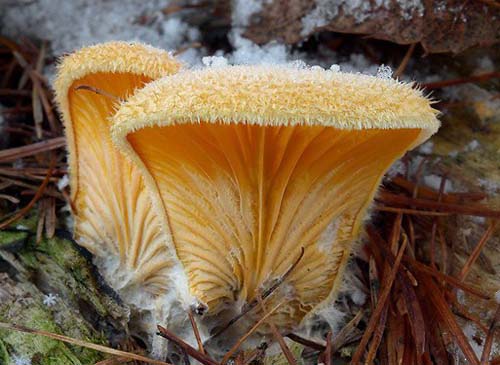
Edible: In most cases, the mushroom is inedible due to the tough pulp (and especially the skin) and the unpleasant odor. However, in some regions of Russia, young oyster mushrooms are eaten as conditionally edible mushrooms of the 4th category. Perhaps some other form is growing there. We are sure that it is quite enough to admire orange oyster mushroom, although in winter (with a shortage of other mushrooms) it looks very appetizing. But if you decided to eat the oyster mushroom, then you need to boil it for 20 minutes, drain the broth, and then boil or stew.
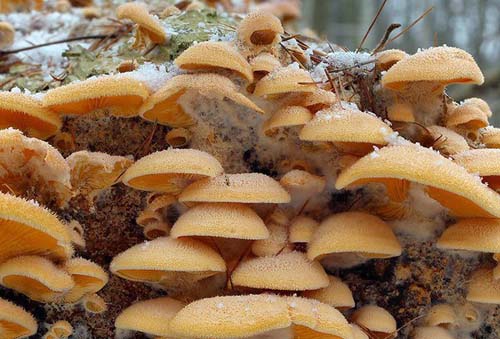
Notes: This is one of the most beautiful winter mushrooms - a true decoration of our forests. The species is common in Western Europe, Belarus, the European part of Russia (from the Komi Republic and the Vologda region to the Moscow region), the Caucasus and Eastern Siberia (incl. Krasnoyarsk Territory) The species is included in the Red Book of the Leningrad Region. In our opinion, it is completely in vain, since it is extremely widespread and only expands its range.
Preparation
Processing oyster mushrooms in this case will not take much of your time. Before you start cooking, you need to learn a few simple but important rules:
- It is necessary to cut these mushrooms before the start of cooking, and not after it.
- If you fry or bake oyster mushrooms, then you should not cook them before;
- Before starting cooking, the fruit bodies must be thoroughly rinsed under running water;
- Do not soak oyster mushrooms.
Mushroom cleaning
To carry out this operation you will need:
- Pour the mushrooms into a colander.
- Rinse thoroughly under cold water. It is better to put some oyster mushrooms in a colander so that they are better cleaned.
- Cut off with a knife those places that are rotten or dry.
- Rinse well again under running water.
Frying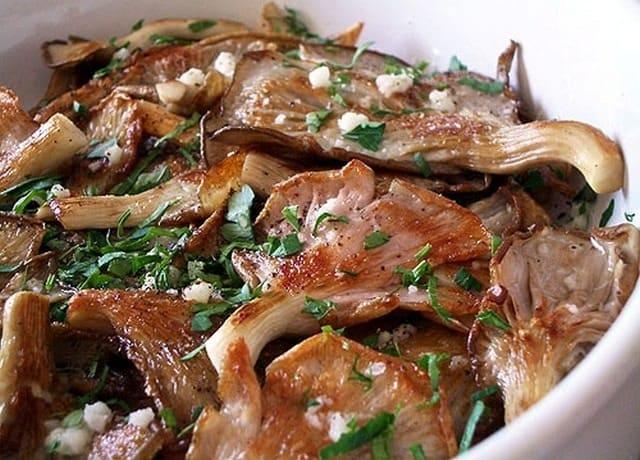
You will need to do the following:
- Cut the mushrooms into small pieces and put on a hot skillet with vegetable oil.
- Fry until golden brown.
- Season with salt and pepper to taste.
Extinguishing
Ingredients:
- 1 kg of mushrooms;
- 2 pcs. Luke;
- 20 grams of chopped greens (dill and parsley);
- 5 g salt;
- 5 g of pepper;
- 350 ml sour cream.
Preparation:
- Chop the mushrooms into small pieces.
- Cut the onion into cubes and sauté for 7 minutes until golden brown.
- Add the chopped oyster mushrooms and fry until the liquid is gone.
- Add herbs, salt, pepper and sour cream.
- Simmer for 15 minutes.
Pickling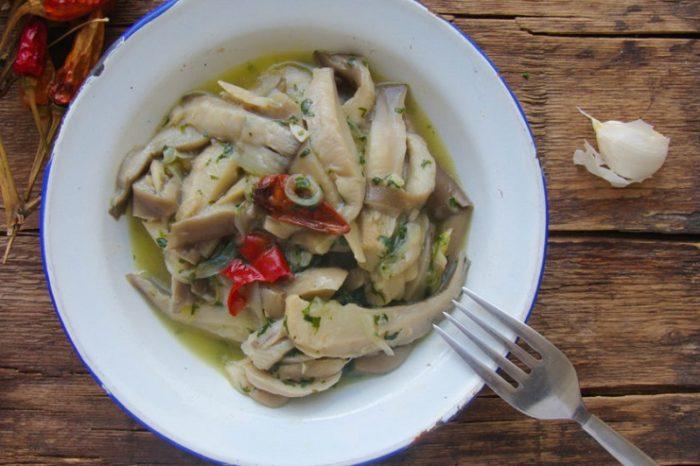
Ingredients:
- 1 kg of mushrooms;
- 2 onions;
- 200 g of water;
- 50 g sugar;
- 10 g salt;
- 30 ml vinegar;
- 3 cloves of garlic.
Preparation:
- Cut the washed and peeled mushrooms into small slices and put them in a container with salted water.
- Cook for about 10 minutes.
- Place the oyster mushrooms in a colander.
- Cut the onions into half rings.
- Separately combine water, garlic, sugar, salt and vinegar in a small saucepan.
- Place a layer of mushrooms in a deep container, put onions on top, then repeat the sequence.
- Pour marinade over and put under pressure.
- Cooking pickled oyster mushrooms will take 8 hours. The workpieces should be stored in a cool place.
Biological description
Fruit bodies are numerous, capped, sessile, small and medium in size, fan-shaped, kidney-shaped or almost rounded. The upper surface of the cap is covered with whitish hygrophane pubescence, pale yellow, pinkish-orange or yellow-orange, pale yellow when dry. The edge of the cap in young mushrooms is always tucked up, occasionally unbending towards old age. The pulp is yellowish, in young mushrooms with a faint pleasant odor, with age and when it dries, it changes to a rather strong, unpleasant one.
The hymenophore is lamellar, the plates are more intensely colored than the cap, from pink-yellow to rust-orange, frequent, with a solid edge. The spore print is pink, soon fading to whitish.
The cuticle of the cap is a cutis covered with hairs resembling trichodermis. Buckled hyphae. Pileocystids are absent or rather numerous, filamentous. Cheilocystids are available. Basidia are tetrasporous, allantoid spores, 5-6.5 × 2.5-3 µm, non-amyloid.
Cases of food poisoning with phyllotopsis are not known, however, the fruiting bodies of the fungus have a tough consistency and, often, an unpleasant odor that persists during processing. Refers to inedible mushrooms.
Similar species
Another species of the genus is known that grows in Central Asia and North America - weak nesting phyllotopsis. It is distinguished by elongated, sometimes almost rounded spores, a brighter orange color and thinner and more rare plates.
Young fruiting bodies of phyllotopsis resemble tapinella panusovida mushrooms, but adult specimens differ significantly. The fruiting bodies of the saffron-lamellar crepidote, characterized by brownish scales on the cap and brown spore powder, also have an orange color.
Description
This type of mushroom has the scientific name - Nest-like Phillotopsis, or it is also called Nest-like Phillotopsis, Nest Oyster mushroom. In Latin, the name looks like this: Phyllotopsis nidulans.
Belongs to the Tricholomataceae family (Tricholomaceae or Rows), genus Phyllotopsis (Phyllotopsis).
Hat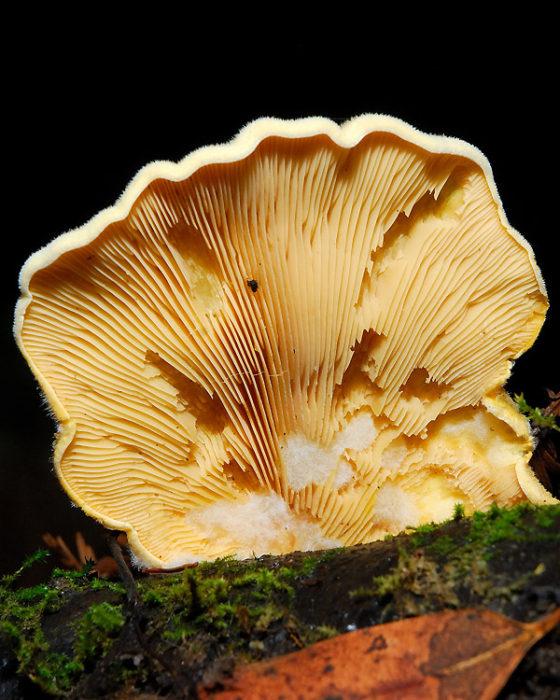
It has an average diameter of 20 to 80 millimeters. Able to grow to the leg as one of the sides and in the middle. In most cases, it is a dry form, has a distinctive feature in the form of a bulge. Covered with fluff, which is very densely located on the surface.
If the mushroom is young, then the cap will be slightly curved. As for the older specimens, this part is omitted, quite often it contains certain irregularities. The surface of the cap can be orange, yellow, or other shades of orange.
Quite often, the roots in this plant are yellow
It is important to know that those hats that have been able to overwinter have slightly lost their color brightness. Oyster mushroom pulp is juicy, thin, rusty-yellow
Hymenophore
The bottom has a number of different plates, which, as a rule, diverge from the base of the mushroom and go up. Plates of this type are in most cases much brighter than the cap itself, rather wide and frequent, and may vary in length. The color starts from a dark shade of yellow to orange.
Pulp
The pulp has a bitter taste. Many experts compare it to the smell of rotting fruit, melon or cabbage. These parameters depend on the age of the fungus and the soil-substrate in which it grows.
Spore powder: pale pinkish to pinkish-brownish shades. Spores are smooth, not amyloid, oblong-elliptical.

